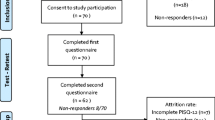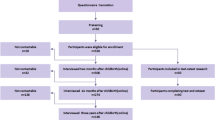Abstract
This study aimed to evaluate the responsiveness of the electronic Personal Assessment Questionnaire-Pelvic Floor (ePAQ-PF) in women undergoing surgery for pelvic floor disorders. Fifty-four women undergoing tension-free vaginal tape (TVT) and 47 women undergoing prolapse surgery completed ePAQ-PF at baseline and 3 months postoperatively. Responsiveness was calculated using effect sizes, standardized response means, responsiveness statistic, and minimally important difference. In the TVT group, the largest effect sizes were seen in the urinary domains for stress urinary incontinence (2.4), quality of life (2.2), and overactive bladder (0.9). In the prolapse group, the largest effect sizes were seen in the vaginal domains for prolapse (2.1) and quality of life (1.0). ePAQ-PF is responsive to change in women undergoing TVT or prolapse surgery in the salient and expected domains of stress incontinence and prolapse and quality of life and can be recommended for outcome measurement in this context.
Similar content being viewed by others
References
Eva UF, Gun W, Preben K (2003) Prevalence of urinary and fecal incontinence and symptoms of genital prolapse in women. Acta Obstet Gynecol Scand 82:280–286
Pauls RN, Silva WA, Rooney CM, Siddighi S, Kleeman SD, Dryfhout V, Karram MM (2007) Sexual function after vaginal surgery for pelvic organ prolapse and urinary incontinence. Am J Obset Gynecol 197(622):e1–e7
Rogers RG, Kammerer-Doak D, Darrow A, Murray K, Qualls C, Olsen A, Barber M (2006) Does sexual function change after surgery for stress urinary incontinence and/or pelvic organ prolapse? A multicenter prospective study. Am J Obstet Gynecol 195:e1–e4
Ghoniem G, Stanford E, Kenton K, Achtari C, Goldberg R, Mascarenhas T, Parekh M, Tamussino K, Tosson S, Lose G, Petri E (2008) Evaluation and outcome measures in the treatment of female urinary stress incontinence: International Urogynecological Association (IUGA) guidelines for research and clinical practice. Int Urogynecol J Pelvic Floor Dysfunct 19:5–33
Radley SC, Jones GL, Tanguy EA, Stevens VG, Nelson C, Mathers NJ (2006) Computer interviewing in urogynaecology: concept, development and psychometric testing of an electronic pelvic floor assessment questionnaire in primary and secondary care. Br J Obstet Gynaecol 113:231–238
Jones GL, Radley SC, Lumb J, Jha S (2008) Electronic pelvic floor symptoms assessment: tests of data quality of ePAQ-PF. Int Urogynecol J Pelvic Floor Dysfunct 19:1337–1347, Epub ahead of print
Bowling A (2005) Measuring health—a review of quality of life measurement scales, 3rd edn. Open University Press, Milton Keynes
Fayers PM, Machin D (2007) Quality of life—the assessment, analysis and interpretation of patient-reported outcomes, 2nd edn. Wiley, Chichester
Guyatt G, Walter S, Norman G (1987) Measuring change over time: assessing the usefulness of evaluative instruments. J Chron Dis 40:171–178
McCracken GR, Henderson NA, Ashe RG (2007) Five year follow-up comparing tension-free vaginal tape and colposuspension. Ulster Med J 76:146–149
Nygaard IE, McCreery R, Burbaker L et al (2004) Abdominal sacral colpopexy in 163 women with posthysterectomy vaginal vault prolapse and enterocele: evolution of operative techniques. J Reprod Med 37:323–327
Ward KL, Hilton P, UK and Ireland TVT Trial Group (2004) A prospective multicenter randomized trial of tension-free vaginal tape and colposuspension for primary urodynamic stress incontinence: two-year follow-up. Am J Obstet Gynecol 190:324–331
Ward KL, Hilton P, UK and Ireland TVT Trial Group (2008) Tension-free vaginal tape versus colposuspension for primary urodynamic stress incontinence: 5-year follow up. BJOG 115:226–233
Walters SJ, Brazier JE (2003) What is the relationship between the minimally important difference and health state utility values? The case of the SF-6D. Health Qual Life Outcomes 1:4
Guyatt GH, Osoba D, Wu AW, Wyrwich KW, Norman GR, Clinical Significance Consensus Meeting Group (2002) Methods to explain the clinical significance of health status measures. Mayo Clin Proc 77:371–383
Lydick E, Epstein RS (1993) Interpretation of quality of life changes. Qual Life Res 2:221–226
Lohr KN, Aaronson NK, Alonso J, Burnam MA, Patrick DL, Perin EB (1996) Evaluating quality of life and health status instruments: development of scientific review criteria. Clin Ther 18:979–992
Kazis L, Anderson J, Meenan R (1989) Effect sizes for interpreting changes in health status. Med Care 27:178–189
Cohen J (1977) Statistical power analysis for the behavioural sciences. Academic, New York
Jenkinson C (1994) Measuring health and medical outcomes. UCL Press, London
Guyatt GH, Eagle DJ, Sackett B (1993) Measuring quality of life in the frail elderly. J Clin Epidemiol 46:1433–1444
Colwell H, Mathias SD, Pasta DJ, Henning JM, Steege JF (1998) A health-related quality of life instrument for symptomatic patients with endometriosis: a validation study. Am J Obset Gynecol 179:47–55
Hajiro T, Nishimura K (2002) Minimal clinically significant difference in health status: the thorny path of health status measures? Eur Respir J 19:390–391
Guyatt GH, Feeny D, Patrick D (1991) Proceedings of the international conference on the measurement of quality of life as an outcome in clinical trials: postscript. Controlled Clin Trials 12:266s–269s
Ulmsten U, Henriksson L, Johnson P, Varhos G (1996) An ambulatory surgical procedure under local anaesthesia for treatment of female urinary incontinence. Int Urogynecol J pelvic Floor Dysfunct 7:81–86
Ward K, Hilton P, United Kingdom and Ireland Tension-free Vaginal Tape Trial Group (2002) Prospective multicentre randomised trial of tension-free vaginal tape and colposuspension as primary treatment for stress incontinence. BMJ 325(7355):67, 13
Gustilo-Ashby AM, Paraiso MF, Jelovsek JE, Walters MD, Barber MD (2007) Bowel symptoms 1 year after surgery for prolapse: further analysis of a randomised trial of rectocele repair. Am J Obstet Gynecol 197:76.e1–e5
Hiller L, Bradshaw HD, Radley SC, Radley S (2007) Criterion validity of the BBUSQ-22: a questionnaire assessing bowel and urinary tract symptoms in women. Int Urogynecol J Pelvic Floor Dysfunct 18(10):1133–1137, Oct
Juniper EF, Guyatt GH, Willan A, Griffith LE (1994) Determining a minimal important change in a disease-specific Quality of Life Questionnaire. J Clin Epidemiol 47:81–87
Badia X, Webb SM, Prieto L, Lara N (2004) Acromegaly quality of life questionnaire (AcroQoL). Health Qual Life Outcomes 2:13, 27
Acknowledgments
We would like to thank all the women who completed the ePAQ-PF and we are grateful for their support in enabling the instrument to be used as part of their routine clinical care.
Conflicts of interest
G.L.J., J.L., and A.F. have no conflicts of interests to declare. S.C.R. is a director of EPAQ systems Ltd., a recently formed NHS spinout technology company
Author information
Authors and Affiliations
Corresponding author
Rights and permissions
About this article
Cite this article
Jones, G.L., Radley, S.C., Lumb, J. et al. Responsiveness of the electronic Personal Assessment Questionnaire-Pelvic Floor (ePAQ-PF). Int Urogynecol J 20, 557–564 (2009). https://doi.org/10.1007/s00192-008-0790-9
Received:
Accepted:
Published:
Issue Date:
DOI: https://doi.org/10.1007/s00192-008-0790-9




